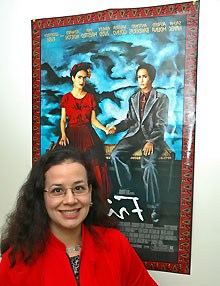For more archives, go to the Advance Archive/Search Page.
Rios Studies Communication
Between Latinos And African-Americans
Picture a community meeting in which African-Americans and Latinos who live in the same neighborhood are discussing a local crisis - perhaps an incident of racial profiling or a problem in the school system. Will these "blacks and browns," as Diana Rios calls them, be able to communicate with each other effectively?
 |
Diana Rios, associate professor of communication sciences, says cross-cultural communication is hindered by lack of knowledge.
|
Rios, an associate professor who holds a joint appointment in communication sciences and Puerto Rican and Latino studies, grapples with that issue in her research. A specialist in mass communication and cross-cultural communication, Rios is delving into the emerging interdisciplinary field of "brown and black communication."
Her first book on the subject, Brown and Black Communication: Latino and African American Conflict and Convergences in Mass Media (published in 2003 and co-edited with Ali Mohammed of Edinboro University of Pennsylvania), is a compendium of data tables, research, and articles by a number of scholars. Rios is working on a follow-up book, Brown and Black Culture and Communication, based upon her own research.
"Latinos and African-Americans are the two largest ethnic groups in the U.S. and they often live in the same part of town," says Rios. Yet little research has explored brown and black communication, primarily, she says, because scholars, the media, and the public tend to rely upon a paradigm that characterizes minority cultures in relation to the dominant white culture rather than in relation to each other.
At the heart of Rios's research is the manner in which cultural differences and perceptions have an impact on communication processes. Over the past several years she has visited Latino and African-American neighborhoods, church gatherings, and community centers in such places as the San Francisco Bay area and Dallas, where Latinos and African-Americans live side by side. Her ethnographic field techniques, including surveys and interviews, have yielded a wealth of data and an eyewitness's perspective on how the lack of cultural knowledge hinders cross-cultural interaction.
Rios tells of interviewing a Latina from California who stated that while blacks complained about racism, what they really needed to do was start working really hard and not go on welfare. Lack of real knowledge or dependence on media portrayals of other cultures, says Rios, can lead to this kind of unhelpful stereotyping.
In another example, she tells the story of being at a potluck in Texas, where an African-American deacon at a traditionally African-American Catholic church was complaining about the influx of Mexican-Americans, who wanted changes at the church, including having a Spanish-speaking priest. While Latinos tend to value both English and Spanish, Rios says, African-Americans tend to perceive Spanish as a foreign language that makes them uncomfortable.
In the book she is drafting, Rios sets out to prove that there is plenty of common ground upon which to build better cultural understanding and cross-cultural communication between browns and blacks.
One example of a cultural value that both Latinos and African Americans share is respect for elders. Says Rios, "In each community, the way people would address older people would be with a tone of voice and word choice that are more respectful." Both groups, she says, also share similar views on the importance of family, and on the value of collectivity as opposed to individualism.
In addition to presenting the common ground, Rios's work addresses demographic trends, the impact of the mass media on the perceptions that Latinos and African-Americans have of one another, variations in verbal and non-verbal expression among the two groups, and conflict resolution.
Rios's interest in cross-cultural communication goes back to her childhood. Her own family is Mexican-American, and her parents were grass-roots activists. As a child and as a teenager, she attended community meetings, where she observed the way people communicated. In her adult life, she has resided in cities and towns with large or emerging Latino and African-American communities in California, Arizona, New Mexico, Texas, and Connecticut. She says her book is based on academic research but is tempered by her first-hand experiences.
Rather than presenting her work to the academic world alone, Rios is designing her book to be "affordable, portable, and accessible to academics and nonacademics alike." While it will quite naturally be suited to the curricula of cross-cultural communication courses, Rios believes it will also be beneficial to professional organizations, non-profits, governmental offices, and community organizations - not to mention to the neighbors trying to work together in that hypothetical community meeting that is always at the back of Rios's mind.
"I want this to be used," she says. "I want people to pause and think about these really important relationships. I think that bridging cultures is very valuable for our society. It's one way of attacking racism."
Rios is on sabbatical this semester at the University of California-Berkeley, where she intends to complete her research and her book.

